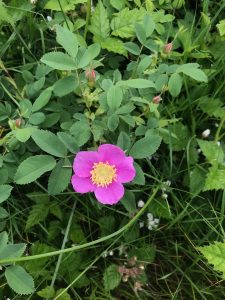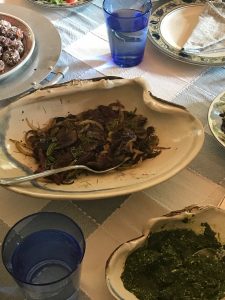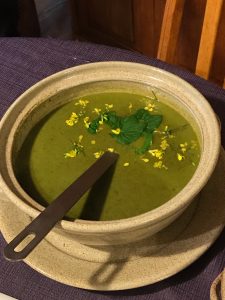My dear daughter-in-law, Jenny, and I made some new friends today. We joined Karen Sherwood of Earthwalk Northwest for one of a series of day classes in which we learn how to identify wild plants and their many virtues: food, medicine, tools. In the classroom, Karen explained the ethical principles and wild food foraging guidelines. She encouraged us to bring wild plants into our lives – make new friends by learning about one plant every week and incorporating wild food on to our plates as often as possible.
Karen’s words also expressed a sense of appreciation and even reverence about using and also safeguarding the wild we have left. In her article, Returning the Gift, scientist, writer, professor Robin Wall Kimmerer writes:
We are showered every day with the gifts of the Earth, gifts we have neither earned nor paid for: air to breathe, nurturing rain, black soil, berries and honeybees, the tree that became this page, a bag of rice and the exuberance of a field of goldenrod and asters at full bloom.
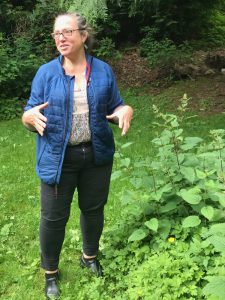 Karen affirmed appreciation, gratitude and wonder at every stop along the trail. We started in her backyard which is home to many wild plants including stinging nettle. Urtica dioica is also sometimes referred to as Indian spinach – a superfood high in chlorophyll, vitamins, minerals and protein. Fresh or dried leaves can be used as a tonic. Dried leaves can be ground and added to any dish. We savored one of Karen’s specialties is a stinging nettle “chip” made by either baking or dehydrating raw leaves coated with a delicious nut oil. As medicine the plant has been used for arthritis, asthma and allergies.
Karen affirmed appreciation, gratitude and wonder at every stop along the trail. We started in her backyard which is home to many wild plants including stinging nettle. Urtica dioica is also sometimes referred to as Indian spinach – a superfood high in chlorophyll, vitamins, minerals and protein. Fresh or dried leaves can be used as a tonic. Dried leaves can be ground and added to any dish. We savored one of Karen’s specialties is a stinging nettle “chip” made by either baking or dehydrating raw leaves coated with a delicious nut oil. As medicine the plant has been used for arthritis, asthma and allergies.
Steps away from a plant that stings is a plant that can soothe skin irritation by neutralizing the formic acid with its alkaline secretions: broad-leaved dock plant. 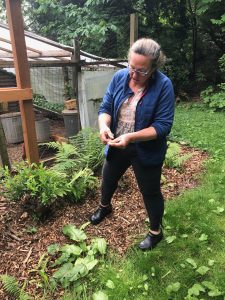 Find the unfurled inner leaves of Rumex obtusifolius and you’ll feel a goopy serum you can apply to your nettle rash. Or you can apply crushed leaves as a poultice. Sauté the new leaves for a nutritional boost of vitamins C, A, protein and iron. Broad leaf and curly dock, Rumex crispus, leaves can be eaten like spinach. As the plant matures, you can winnow curly dock seeds and grind them to make baking flour. As medicine curly dock root has been used to tonify the gallbladder and boost bile production.
Find the unfurled inner leaves of Rumex obtusifolius and you’ll feel a goopy serum you can apply to your nettle rash. Or you can apply crushed leaves as a poultice. Sauté the new leaves for a nutritional boost of vitamins C, A, protein and iron. Broad leaf and curly dock, Rumex crispus, leaves can be eaten like spinach. As the plant matures, you can winnow curly dock seeds and grind them to make baking flour. As medicine curly dock root has been used to tonify the gallbladder and boost bile production.
 Karen pointed out many plants that are often overlooked as “commoners” like dandelion, Taraxacum officinale. These edible weeds are high in potassium, calcium, magnesium, iron, vitamins A, B and C. (They are welcome neighbors growing in the grass around my house!)
Karen pointed out many plants that are often overlooked as “commoners” like dandelion, Taraxacum officinale. These edible weeds are high in potassium, calcium, magnesium, iron, vitamins A, B and C. (They are welcome neighbors growing in the grass around my house!) 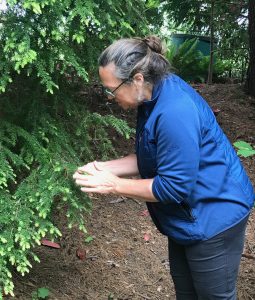 Karen recommended making simple teas from the early buds of Western hemlock, Tsuga heterophylla and Douglas fir Pseudotsuga menziesii. The citrus tasting teas are infused with vitamin C. They have also been used to combat scurvy, colds, coughs and fatigue. Appreciating what we take for granted enriches our lives immeasurably.
Karen recommended making simple teas from the early buds of Western hemlock, Tsuga heterophylla and Douglas fir Pseudotsuga menziesii. The citrus tasting teas are infused with vitamin C. They have also been used to combat scurvy, colds, coughs and fatigue. Appreciating what we take for granted enriches our lives immeasurably.
I think we appreciate when we slow down and train our senses to abide with the place we find ourselves. Zen poet Jane Hirshfield writes:
 The danger of familiarity is that it’s comfortable. And when something becomes familiar it stops being remarkable. Without the work of mindfulness, the little noticings go first and quietly accumulate in the corner of lost things, that first spring crocus, no, go even closer — the way the color divides and splays on the petals.
The danger of familiarity is that it’s comfortable. And when something becomes familiar it stops being remarkable. Without the work of mindfulness, the little noticings go first and quietly accumulate in the corner of lost things, that first spring crocus, no, go even closer — the way the color divides and splays on the petals.
Karen has a remarkable ability to shine light on these lost things. She explained dandelion is a cleansing plant. Its leaves act like bitters to stimulate digestion. They are rich in vitamins and minerals, calcium, iron and potassium among others. The tea made of roasted roots supports liver function. The roasting process breaks down inulin and creates fructose. Karen’s powdered the roasted roots to make a “coffee” ice cream. Dandelion was highly valued by native people. The Apache travelled two days to dandelion patches.
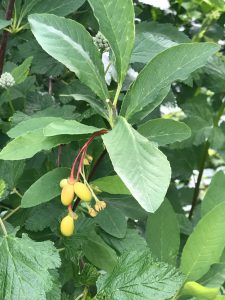 As the day progressed I sensed nature’s abundance. Karen guided us along trails pointing out amazing plants every ten yards – we were surrounded! She pointed out Indian plum, Oemleria cerasiformis, one of the first plants to flower in the early Spring now beginning to fruit. The pithy plums – also called osoberries can be eaten fresh, cooked, or dried. Twigs and bark for various medicinal uses.
As the day progressed I sensed nature’s abundance. Karen guided us along trails pointing out amazing plants every ten yards – we were surrounded! She pointed out Indian plum, Oemleria cerasiformis, one of the first plants to flower in the early Spring now beginning to fruit. The pithy plums – also called osoberries can be eaten fresh, cooked, or dried. Twigs and bark for various medicinal uses.
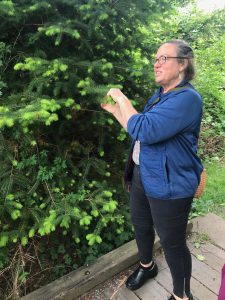 You know you have found spruce when you feel the stiff sharp needles. You can sauté the tender tips or bake them inside fish to add lemony flavor. Ferment them as beer. The resin from higher branches is a powerful antimicrobial. Studies show successful treatment of antibiotics-resistant wound infections. You can peel off the dried pitch and infuse it with olive oil, add beeswax and make a salve.
You know you have found spruce when you feel the stiff sharp needles. You can sauté the tender tips or bake them inside fish to add lemony flavor. Ferment them as beer. The resin from higher branches is a powerful antimicrobial. Studies show successful treatment of antibiotics-resistant wound infections. You can peel off the dried pitch and infuse it with olive oil, add beeswax and make a salve.
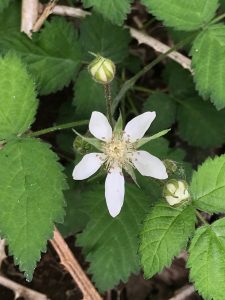 Karen distinguished our native Trailing blackberry from the Evergreen and Himalayan blackberries. Rubus ursinis leaves make good tea – like so many wild plants – full of vitamins and minerals. Like rose, blackberry is astringent and is particularly helpful for toning reproduction organs in women and men. It is a great tea to drink regularly in the perinatal year!
Karen distinguished our native Trailing blackberry from the Evergreen and Himalayan blackberries. Rubus ursinis leaves make good tea – like so many wild plants – full of vitamins and minerals. Like rose, blackberry is astringent and is particularly helpful for toning reproduction organs in women and men. It is a great tea to drink regularly in the perinatal year!
 Hawthorn, Crataegus monogyne, offers powerful support for our cardiovascular system – its flowers, fruits and leaves can be made into a simple tea. It increases the heart muscles ability to contract while relaxing blood vessels helping to normalize blood pressure and relieve arrhythmias. The antioxidants and flavonoids help reduce atheroscherosis, which contributes to angina and heart attacks. Drinking this simple tea along with a healthy diet has been shown to eliminate the need for blood pressure medicine. Its astringent qualities are also helpful for digestion issues.
Hawthorn, Crataegus monogyne, offers powerful support for our cardiovascular system – its flowers, fruits and leaves can be made into a simple tea. It increases the heart muscles ability to contract while relaxing blood vessels helping to normalize blood pressure and relieve arrhythmias. The antioxidants and flavonoids help reduce atheroscherosis, which contributes to angina and heart attacks. Drinking this simple tea along with a healthy diet has been shown to eliminate the need for blood pressure medicine. Its astringent qualities are also helpful for digestion issues.
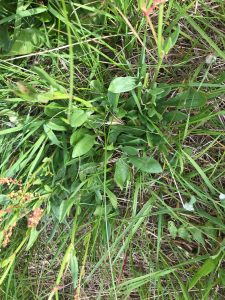 Karen pointed out a number of herbs growing in trailside grasses. Sheep sorrel, Rumex acetosella, is a rich source of vitamins C, E, beta-carotene, and other carotenoids. Rich in antioxidants it adds a lemony flavor to salads and soups. Sheep sorrel has been used to treat inflammation and diarrhea, scurvy and cancer.
Karen pointed out a number of herbs growing in trailside grasses. Sheep sorrel, Rumex acetosella, is a rich source of vitamins C, E, beta-carotene, and other carotenoids. Rich in antioxidants it adds a lemony flavor to salads and soups. Sheep sorrel has been used to treat inflammation and diarrhea, scurvy and cancer. 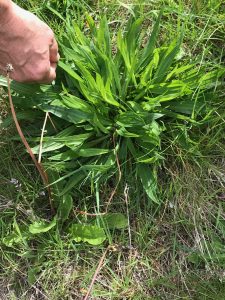 Plantain, Plantago major, leaves are edible as salad greens when young and tender. The older leaves can be cooked in stews. The nutritious leaves contain vitamin A, calcium and other minerals. Like curly dock, the seeds can be harvested, ground and used as flour.
Plantain, Plantago major, leaves are edible as salad greens when young and tender. The older leaves can be cooked in stews. The nutritious leaves contain vitamin A, calcium and other minerals. Like curly dock, the seeds can be harvested, ground and used as flour.
Burdock, Arcticum minus, is known for its roots. They ave a crisp, sweet, mild and pungent flavor.  Tender new leaves make a great salad green and a wrapping for other foods. It promotes digestion and acid/alkaline balance in the body and supports liver function.
Tender new leaves make a great salad green and a wrapping for other foods. It promotes digestion and acid/alkaline balance in the body and supports liver function.
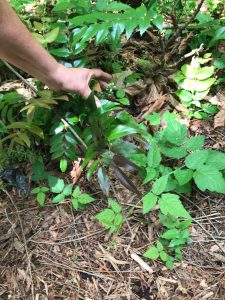 Oregon grape, Mahonia nervosa, is a powerful medicinal plant used for stomach ulcers, gastroesophageal reflux disease and stomach upset. It is used to treat infections, as a bitter tonic AND its fresh berries can be eaten or made into a delicious jelly!
Oregon grape, Mahonia nervosa, is a powerful medicinal plant used for stomach ulcers, gastroesophageal reflux disease and stomach upset. It is used to treat infections, as a bitter tonic AND its fresh berries can be eaten or made into a delicious jelly! 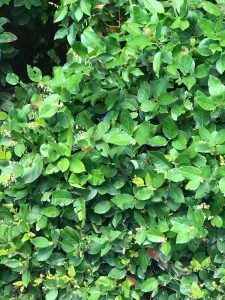 Salal is abundant on this side of the Cascades. Its plentiful flowers yield black berries containing more antioxidants than any other berry.
Salal is abundant on this side of the Cascades. Its plentiful flowers yield black berries containing more antioxidants than any other berry. 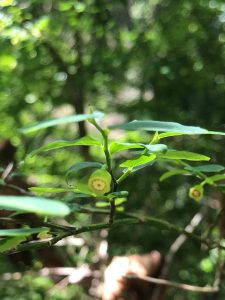 They are a great trail side nibble and can be made into jellies, syrups and berry cakes. Karen introduced these plants as her old friends. They offer so much to those who are ready to receive their gifts! We happily gathered a bit here and there to incorporate into our wild foods feast!
They are a great trail side nibble and can be made into jellies, syrups and berry cakes. Karen introduced these plants as her old friends. They offer so much to those who are ready to receive their gifts! We happily gathered a bit here and there to incorporate into our wild foods feast!
Back in the Earthwalk kitchen we assembled our foraged ingredients. We chopped rose petals and transformed into rose petal honey – a wonderful accompaniment to Karen’s nettled cornbread muffins.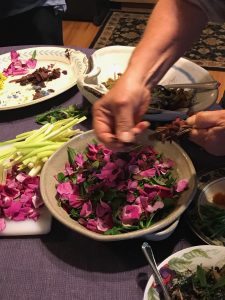
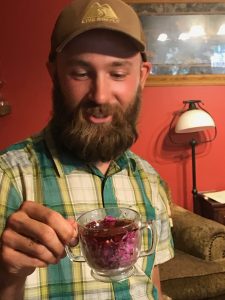
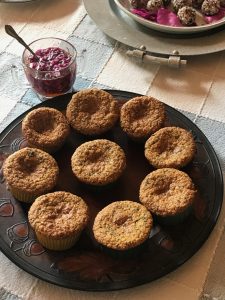

Chopped rose and salmonberry petals combined with ground hazelnuts and shredded coconut in Karen’s Wild Flower Coconut Hazel cookies. 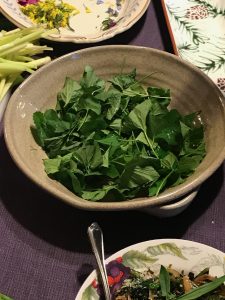
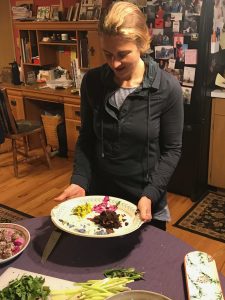
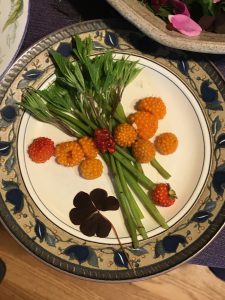 We built our Salmonberry-Wood Sorrel Salad on a bed of wild violets. We assembled side dishes:
We built our Salmonberry-Wood Sorrel Salad on a bed of wild violets. We assembled side dishes:
Peeled salmonberry shoots and berries, roasted cattail shoots with parmesan and dandelion pesto. Karen served us a beautiful cream of leek and violet soup and last, but not least, duck medallions with sautéed spruce tips:
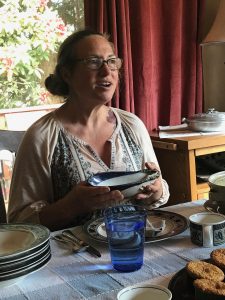 Karen has a tradition of serving her beautiful food with a gratitude ceremony. Each one of us placed a bit of our feast on a plate to be returned to nature – for the birds, insects, critters. We savored nature’s goodness and the goodness of our own natures in good conversation.
Karen has a tradition of serving her beautiful food with a gratitude ceremony. Each one of us placed a bit of our feast on a plate to be returned to nature – for the birds, insects, critters. We savored nature’s goodness and the goodness of our own natures in good conversation.
Here is a sweet poem from Jane that holds the spirit of our gathering:
My Species
even
a small purple artichoke
boiled
in its own bittered
and darkening
waters
grows tender,
grows tender and sweet
patience, I think,
my species
keep testing the spiny leaves
the spiny heart

